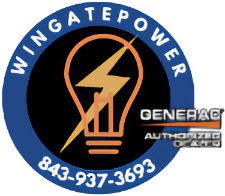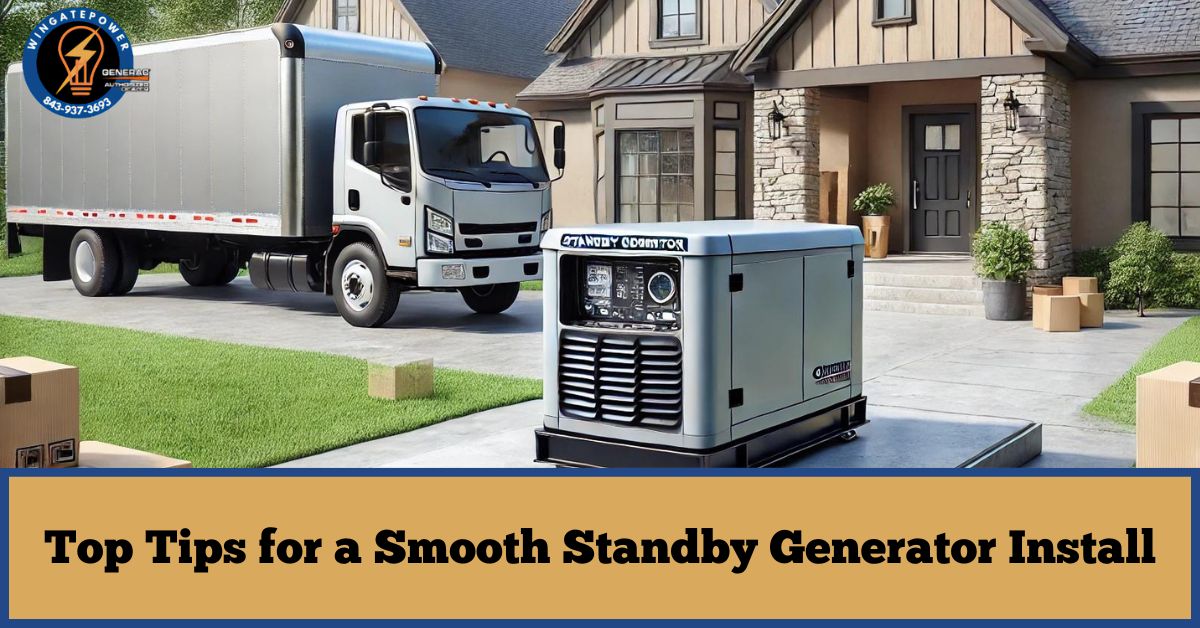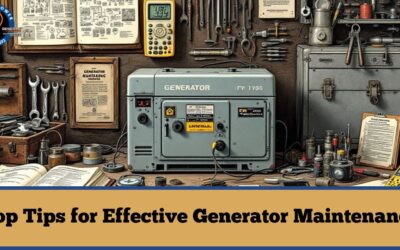Looking to keep your home powered during outages? A standby generator install is the solution. In this guide, we’ll cover key steps for a smooth and efficient installation, from selecting the right generator to ensuring safety.
Key Takeaways
- Choosing the right standby generator is crucial; consider power needs, noise levels, and professional consultation to find the ideal model.
- Proper home and site preparation, including clearing obstructions and installing a concrete pad, ensures a smooth generator installation.
- Understanding and using transfer switches can provide seamless power transition during outages, and choosing the right fuel supply type is essential for reliability.
Choosing the Right Standby Generator
The initial step towards a smooth installation is making the right home standby generator selection. There are various types of generators, each suited for different needs. Standby generators are the go-to for most homeowners because they automatically sense power outages and activate without manual intervention. This convenience sets them apart from portable generators, which are smaller, mobile units that require manual starting and fueling, often with gasoline or propane. A portable generator, on the other hand, offers more mobility and flexibility for temporary power needs.
Finding the correct generator size is crucial in satisfying your home’s power demands. To do this, follow these steps:
- Add up the wattage requirements of all your essential appliances.
- Include extra capacity for starting watts.
- For instance, a typical 2,500 square-foot home might need a 20kW to 25kW generator.
It’s always advisable to consult with professionals, like WingatePower, who offer free in-home consultations to help you choose the right size.
The model you select also influences the location for installation and the prerequisites for site preparation.
Some factors to consider when selecting a generator model include:
- Power requirements: Diesel generators are ideal for high kW appliances and provide a steady power supply during emergencies. Propane generators are quieter and suitable for smaller setups.
- Noise level: If noise is a concern, consider a propane generator, as they tend to be quieter than diesel generators.
- Size and portability: Consider the size and weight of the generator, especially if you need to move it around frequently.
Selecting the right model ensures that your installation process is smooth and hassle-free.
Preparing Your Home for Installation
Adequate home preparation is vital for successful generator installation. The first step involves selecting an ideal location for the generator. This means considering local building codes, the proximity to your main electrical panel, and ensuring the area is free of obstructions. A stable, well-drained area is crucial to prevent water accumulation around the generator, which could cause damage.
The site preparation includes:
- Clearing any obstacles or debris from the designated installation area
- Ensuring the site is level
- Installing a concrete pad, larger than the generator’s footprint, to provide a stable foundation and prevent the generator from sinking into the ground
- Mounting studs to reinforce the concrete pad and firmly secure the generator.
Before any installation work begins, check your local codes and regulations for the necessary permits. Permits are usually required for installing a generator, and inspections should be arranged to ensure compliance with local codes. Fortunately, companies like WingatePower handle all necessary permits, making the process easier for homeowners.
Understanding Transfer Switches
Any standby generator setup heavily relies on transfer switches. Without a transfer switch, you would need to manually connect your generator to the equipment you want to power, which can be cumbersome and inefficient during an outage. Transfer switches prevent any overlap between utility power and generator power connections, ensuring a seamless transition when the power goes out.
There are two main types of transfer switches: manual and automatic. Manual transfer switches are often used in commercial settings, requiring someone to physically switch the power source. However, for residential use, automatic transfer switches are the preferred choice. These devices connect the generator to the electrical system and automatically switch on the generator when a power outage is detected. This automatic feature provides unparalleled convenience and peace of mind, knowing your home will remain powered without any manual intervention.
Fuel Supply Options
Another vital consideration is choosing the correct fuel supply for your generator.
Generators can run on various fuels, including:
- Natural gas: affordable, widely available, and distributed through a local utility grid, ensuring a continuous supply without the need for manual refueling.
- Propane: portable and can be stored in tanks, making it a good option for remote locations.
- Diesel: efficient and provides a longer runtime, but may require more maintenance.
- Gasoline: readily available but may be less efficient and require more frequent refueling.
Each fuel option offers unique benefits and considerations. Choose the one that best suits your needs and circumstances.
Propane is another excellent option, known for its environmental benefits and indefinite shelf life. It comes in tanks that can be stored on-site, making it convenient for refueling. Diesel fuel, while the least flammable and most energy-packed, is often chosen for its ability to be stored on-site for quick refueling. Gasoline, though the most available, is less commonly used for standby generators due to its higher volatility and shorter shelf life. The gas supply options for these generators vary, but each has its own advantages and disadvantages.
Natural gas and propane are the most common choices for home standby generators due to their reliability and environmental benefits. Natural gas generators, in particular, outperform other fuel types in frigid weather conditions. Ensuring a steady and reliable fuel supply is crucial for maintaining backup power during outages.
The Installation Process
Several key steps are involved in the standby generator installation process to guarantee a smooth operation. It starts with site preparation, followed by electrical system integration, and finally, connecting the fuel line. Each of these steps is crucial for the proper functioning of your standby generator and requires careful planning and execution.
Site Preparation
One of the initial and most vital steps in the installation process is site preparation.
Here are some important considerations:
- Choose a level and stable area for the generator placement.
- For outdoor installations, consider factors like airflow, sound, vibration levels, and environmental conditions.
- For indoor installations, ensure sufficient floor space and clearance on all sides for safe operation.
Preparing the site often involves laying down a concrete pad with mounting studs, providing a stable foundation to prevent the generator from sinking into the ground. This concrete pad ensures the generator remains secure and properly aligned during operation, which is critical for its longevity and performance.
Electrical System Integration
A significant step in the installation process is incorporating the generator into your home’s electrical system. This involves connecting the generator to the main breaker and electrical panel, ensuring that it can supply power to your home during an outage. An automatic transfer switch is essential for this integration, as it allows the generator to kick in automatically when a power outage is detected.
All electrical connections must be properly insulated and covered to prevent electric shock and ensure safe operation. This is why it’s vital to have a licensed electrician handle this part of the installation to comply with safety standards and local codes.
Connecting the Fuel Line
The last step in the installation process is linking the fuel line. This involves aligning the generator with the fuel supply, which could be a natural gas line or a liquid propane tank. Using a flexible fuel line is crucial as it minimizes the risk of damage from vibration during generator operation.
The flexible fuel line should be connected to an approved gas fitting rather than directly to the generator’s fuel inlet. This setup helps isolate vibration and prevents gas leaks, ensuring safe and efficient fuel delivery to the generator.
Safety Considerations
Safety should be the top priority when installing and operating a standby generator. This ensures the well-being of both the equipment and individuals involved. One of the primary concerns is carbon monoxide poisoning, which can occur if exhaust fumes are not properly managed. Ensuring adequate ventilation around the generator is essential to prevent overheating and the buildup of dangerous gases.
It’s also important to keep the area around the generator clean and free of clutter and combustible materials. Having a fire extinguisher nearby is a good precaution, but avoid using carbon tetra-chloride extinguishers due to the toxic fumes they produce. Regular maintenance is critical to reduce the risk of accidents, including carbon monoxide leaks and fires.
Proper grounding or earthing wiring is essential for the generator and any external conducting parts. Additionally, the generator should not be opened or dismantled while it is running, and battery cables should be disconnected before any work is performed to avoid electrical shock or electrocution.
Hiring a Professional vs. DIY Installation
When it comes to installing a whole house generator, hiring a professional is often the best route. Standby generators require professional installation by a licensed electrician to ensure compliance with local codes and to guarantee a safe installation. Professionals have the expertise, specialized tools, and warranties that provide a long-term solution, ensuring that your generator operates efficiently and reliably.
DIY installation may appear to be a cost-effective solution for minor problems, but if mishandled, it can cause additional damage. Although professional installation might initially appear more costly, it can ultimately save money by preventing future damage and extending the generator’s lifespan. The accurate diagnosis and quick resolution of complex issues are significant advantages of hiring a professional.
Generator Maintenance
Regular maintenance is vital to guarantee your generator’s smooth and efficient operation during power outages. Regular inspections help optimize the generator’s efficiency and ensure it remains functional during power outages. Preventive maintenance is recommended to detect minor issues early and prevent them from worsening. Be sure to consult the generator manufacturer’s recommendations to keep your generator operating effectively.
Maintenance should always follow the manufacturer’s instructions and guidelines to ensure safety and effectiveness. Basic maintenance services typically range from $80 to $300, making it a small investment for the reliability it provides. WingatePower offers Annual Maintenance Plans, simplifying the task of keeping your generator reliable and running optimally.
Have Questions About Your Generator Project?
If you have any questions at all, make sure you request a Free In-Home Consultation to find out which generator works best for your home and to get a 100% accurately priced quote.
WingatePower, with over three decades of electrical experience, has helped countless homes stay powered during outages and major storms.
Summary
A standby generator is an invaluable asset for any home, providing peace of mind during power outages. From selecting the right model and preparing your home for installation, to understanding transfer switches and fuel supply options, each step is crucial. Professional installation and regular maintenance ensure your generator operates efficiently and safely.
By following the tips and insights provided in this guide, you can ensure a smooth and hassle-free installation process. Investing in a standby generator is more than just a precaution; it’s a commitment to the safety and comfort of your home. Stay prepared, stay powered, and enjoy the peace of mind that comes with knowing your home is always ready for any power outage.
Frequently Asked Questions
How do I determine the right generator size for my home?
To determine the right generator size for your home, add up the wattage requirements of all essential appliances and include extra capacity for starting watts. It’s highly recommended to consult with professionals for an accurate assessment.
Do I need a permit to install a standby generator?
Yes, you will typically need a permit to install a standby generator. Be sure to check local regulations and arrange for required inspections.
What are the advantages of hiring a professional for generator installation?
Hiring a professional for generator installation offers compliance with local codes, expertise, specialized tools, and warranties, ensuring a safe and reliable installation. Plus, they can quickly resolve complex issues.
What type of fuel is best for standby generators?
The best types of fuel for standby generators are natural gas and propane. Natural gas offers a continuous supply through a local utility grid, while propane has an indefinite shelf life and can be stored on-site.
How often should I perform maintenance on my generator?
You should perform routine maintenance on your generator regularly to ensure it runs smoothly and efficiently during power outages. Regular inspections help detect minor issues early.




![[VIDEO] Why Now is the Best Time to Prepare for Storm Season with a Generator](https://www.wingatepower.com/wp-content/uploads/2025/01/Palmetto-Live-Jan-2025-Segment-WingatePower-Generac-Generators-400x250.jpg)

![[VIDEO] Beating a Charleston Power Outage: Protect Your Home with a Generator](https://www.wingatepower.com/wp-content/uploads/2024/10/Charleston-Power-Outage-Solution-Generators-400x250.jpg)